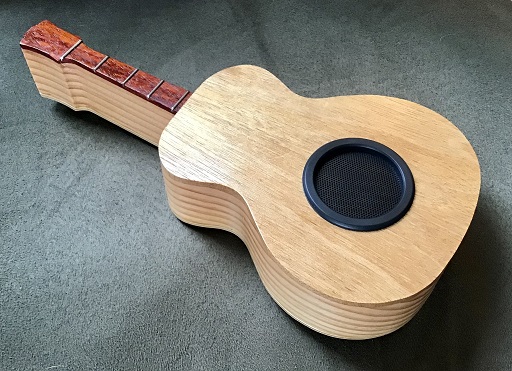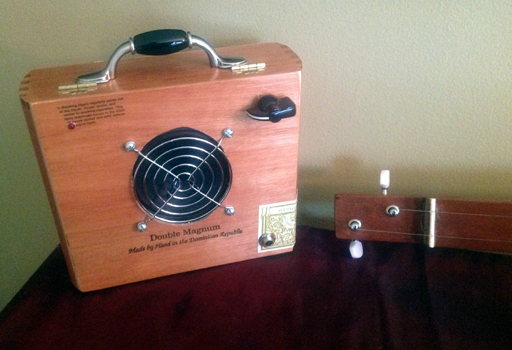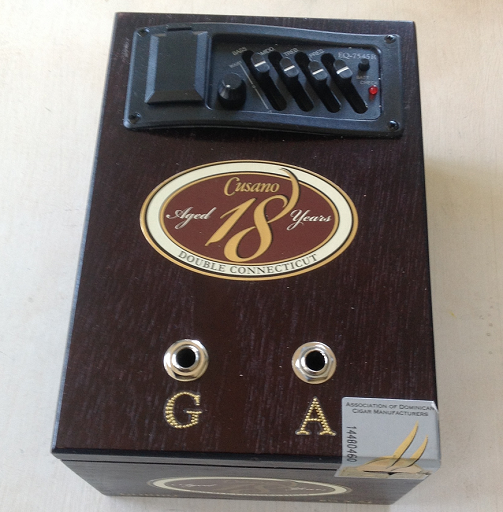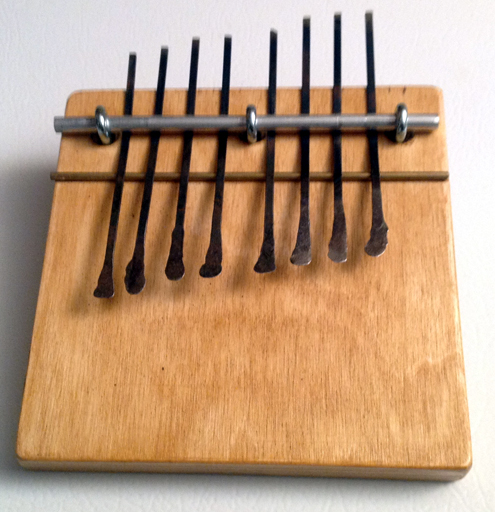Instruments
|
Clementine Box |
|
|
| This was my first mountain dulcimer. The frets are plastic knives
that are hot glued to the fret board. The frets were placed using a tape
measure that was only accurate to about 1/8". So you many of the notes
are quite sharp/flat. Playing chords is not this instrument strong
suite. The tuning mechanism are eye bolts. The other end of the strings
are screwed on with wood screws. The nut and bridge are just
flat pieces of wood that I cut from scrap. The sound box is a Clementine
box that I found in the back room in the basement. The fret board was
just a random piece of wood from the basement as well. Not sure of its
origin. The melody string sounds pretty good and the Clementine box has a nice sound to it. The other two strings are rather buzzy, due to the large flat nut and bridge. But it is good for playing single note songs played against the two drone strings. Total cost was about $5.00. |
|
"The Ark" |
|
|
| This is my second attempt. The strings are still attached and tuned
in the same manor as the T-1. However, the fret placement is much more
accurate and I used a measuring device with 1/64" increments. The frets
are HO scale model train rails that I had laying around. They are hot
glued into place. The bridge and nut are wooden dowels. They are also
hot glued into place. The box itself is constructed from a scrap of
paneling that was left over from redoing the bathroom floor. The panels
are all hot glued together. The fret board is a piece of "craft board"
that I bought at a local home improvement store. The sound from this instrument is rich and full. The upper frets are slightly less accurate than the lower frets because I was forced to measure fret-to-fret, so there are accumulated errors by the time I reached the upper frets. But chording sounds good. Total cost was about $7.00. |
|
KT-1 |
|
|
| My young daughter took a liking to playing daddy's dulcimers. So I
whipped this together for her one evening. It is more of a
Diddley Bow, than
it is a dulcimer. But she didn't mind. She plays it by running a wooden
dowel under the string and plucking the string with a pick. I marked the
frets with a black marker so that I could play "Mary Little Lamb" on the
instrument when requested. It is made completely from scraps laying around. The sound box is made from some wainscoting hot glued together. Total cost: Maybe a $1, if you count the wooden dowel, which used to be a foam brush. The brush was new, so it was probably still worth something. |
|
T-3 |
|
|
| I found that I enjoyed playing the guitar styled dulcimer more than
playing the lap style dulcimer. So I made this one in the guitar style. The fret board is the same wood as used on the T-2. The tuning mechanism are real guitar tuners. The strings are attached with little copper pegs. The nut is a pre-cut dulcimer nut that I bought. But since I only used two strings, I had to re-cut it anyway. The bridge is a machine bolt that I cut the head off of. The frets are made with real fret wire and are cut into the fret board. The frets were placed using a fret board printout printed using CB Frets. The printout was done on a plotter that was able to print the entire fret board on a single sheet of paper. I then taped the paper to the neck board and marked the locations to cut. The sound box is a cigar box that I got at a local cigar shop. The sound holes are brass grommets used for repairing tarps. You cannot see it from this picture, but I also added an electric pickup with a 1/4" jack. The only hot glue used on this instrument was to hold the piezo to the bottom of the fret board inside of the cigar box. This instrument lacks the low end sounds of the previous two, but other than that, it sounds great and is the easiest and most fun to play. Total cost was about $20. Update: I added a pair of official brass Gibson replacement part strap buttons (not pictured) for about $4.50. |
|
KT-2 |
|
|
| After building the T-3, I let the kids play with the T-1 a lot more.
It eventually lived up to its construction level. The eye bolts quit
holding a tune, a string broke, etc. My young daughter waited patiently
for daddy to "fix blue one". But I decided to upgrade her instrument
instead of reworking the T-1. The KT-1 was quite large and heavy for her
to lug around. So I built a smaller, lighter version for her. The image above isn't the final product. I ended up putting on a 22.5% angle for the tuner head because I couldn't get the nut to stop the string vibrations properly. The angle didn't really fix the issue either, but it did make it look more like a real guitar. So at least the effort wasn't for nothing. A penny "string tree" eventually fixed the problem. The sound box is a wooden craft box from a local craft store. Total cost was about $18. The craft box was the most expensive part. And it turns out that high quality stickers of a licensed property are expensive. |
|
Punch Box |
|
|
| The purpose of the T-4 was to test creating a 4-string dulcimer along with using a fret board veneer. The neck is poplar and the fret board is an 1/8" rosewood veneer. The frets, tuners, strap buttons and pickup are the same as on the T-3. The rosewood veneer added about $12 to the construction costs. |
|
|
|
MJ-1 |
|
|
| Shortly after I built the KT-2, my 7 year old daughter started
asking when she was going to get her own guitar. She asked if I would
help her build one. She loves crafts. I warned her that it would be a
long project. She said that she liked long art projects. This is purely
her design. She picked out the finger board veneer. Painted the cigar
box. She wanted the string to be strung so that she could hold it like a
real guitar and not like daddy who plays his "lap dulcimer" on his lap.
She did over 50% of the construction as well. Dad did most of the
drilling and some of the final nut/bolt adjustments, but the rest was
all her work. Dad just walked her through the steps. She cut the wood,
cut and filed the frets, cut the fret slots, sanded, painted, etc. The
project took about 6 months from start to finish (Dad isn't that great
of a hand-man, as this blog can attest too, and there is only so much
time after homework gets done). But she definitely has an instrument
that she can be proud of.
The fret board is purple-heart with just a little Tung Oil and some UV protection sprayed on to help the wood keep its natural purple color. |
|
|
|
T-8 |
|
|
| A little 2-stringer that I built for my mother. She thought it looked easy enough that even she could play one. Her words, not mine. Nothing fancy. No pickup. Sound is similar to the T-3 above. This one has better intonation than the T-3, since I didn't even know what that word meant when I built the T-3. |
|
License Plate |
|
|
| A chromatic 3-string. Uses a flat license plate for the top sound board. The bottom is another license plate with raised letters. The frame was made from a 1 1/2" x 1/4" x 4' board held together with corner brackets. The fret markers are 3/8" wooden flat head plugs, painted white. The fret markers show the diatonic frets. Includes a Piezo pickup. All chrome tuners. |
|
Diddley Bow-3 |
|
|
| A 1-String, fret-less, Diddley Bow. Made from a 7/8" dowel, some hose clamps and a cigar box. Diatonic fret marks. Includes a Piezo pickup. |
|
T-11 |
|
|
| Not counting "the ark" above, this is my first attempt at making a more traditional looking mountain dulcimer. Curved side panels are outside of my skill set, so rectangle shaped it is. The top and bottom are made out of 1/8" birch plywood from a local craft store. The sides are 1/4" poplar from a local big box hardware store. The finger board is a strip of wenge. Though difficult to see in this photo, there are four large sound holes. Each of the larger sound holes are surrounded by four smaller sound holes. Lining up all of those holes by hand would have been outside my skill set as well. So I used a piece of land mapping software to layout the holes. That way I could use math to lineup all of the little holes. I entered everything into the software as feet instead of inches. Then I printed the layout with a scale of 1" = 1'. Then all I had to do was lay the printed piece of paper unto the wood and drill the holes with the proper sized drill bits. The instrument also includes two pickups. A four pole, single coil pickup with a volume control and a piezo pickup without a volume control. Each pickup has its own jack. The fret markers are 6mm abalone. |
|
WJ-1 |
|
|
| My son was 6 when he started this dulcimer. He picked out all the colors and basic design. We wanted to paint the fingerboard red, but it was a nice piece of American Sycamore, with beautiful grain, so thankfully I was able to talk him into staining it instead. He wanted a license plate like the Texas plate above. The front panel is a piece of 1/8" birch plywood from a local craft store. Conveniently it is the same size as the license plate. Of course it had to have an electric pickup, so that it could "sound like an electric guitar". So it includes a little piezo. The instrument is surprisingly loud, even without amplification and probably has the second best sound of any of the instruments currently on this page. |
|
Banjimer |
|
|
| This is a dulcimer-banjo hybrid. I was looking for a different sounding instrument that still let me use my existing playing skill set. This instrument fits that bill. This was my first attempt at doing a pearl inlay. The T at the top is a single piece of peril. The fret dots are off the shelf pre-cut pearl. I added the 1+ fret as a bridge between a full chromatic and the typical diatonic dulcimer layout. The fingerboard and bridge are made from Padauk. Includes a piezo pickup. |
|
T-14 |
|
|
| Very similar in design to the T-11 except this is a full chromatic instrument while the T-11 is diatonic. Same birch plywood top as the T-11. The sides are 1/4" red oak. The neck and tail piece are mahogany. The fret board is African Blackwood. The fret markers are pearl and laid out in the diatonic fret pattern. Same pickups as the T-11. |
|
Ukulele-1 |
|
|
|
Built from a Ukulele kit by C.B. Gitty. This was my first attempt at using hand rub wood dye. |
|
Strummer-1 |
|
|
|
This was my first, non-rectangle shaped build. It is also the first build that was largely made of "scraps". The tuners are from left over sets from prior builds. The single pearl dot was left ever from the T-14 Chromatic build. The finger board is from a piece of Bubinga that has been laying around for years. |
|
T-17 |
|
|
|
This is my first 3-String Guitar. Built for a friend at work. Primarily made from scrapes from prior builds. Includes a piezo disc pickup. |
|
T-18 |
|
|
|
Built as a Christmas present for my sister. Used a small piece of African Blackwood as a spacer under the Padauk bridge |
|
Half Size Reverie Harp |
|
Wireless Speaker 1 |
|
|
|
Amp 1 |
|
|
| What good is having a pickup in the T-3 without having a good amp to go with it? This amp was built using an amp kit sold by C.B. Gitty. The kit included most of the parts, with just a little soldering need to connect everything together. I used a cigar box that matched the cigar box used to make the T-3. It would have been nice to have a circular hole cutter for making the speaker hole, but I don't own one. This box had an oval shaped logo in the center. The logo was just about the size of the speaker. So I cut around the oval shaped logo instead. The oval hole looks a little out of place with the round speaker, but it works. |
|
Pre Amp 1 |
|
|
| A cigar box pre amp. Based on a design by Shane Speal. |
|
Kalimba 1 |
|
|
| After seeing one of these on the
C.B. Gitty website, I figured it looked like something that I could
make. I started by looking at a lot of photos of homemade kalimbas on the internet.
The board is a spruce board that I bought at a local craft store. I cut
it in half and glued the two halves together. The metal bars are from a
local hardware store. The tines are cut from a roll of fish tape. The
ends of the tines were pretty rough on the thumbs, even after filing and
sanding them. So I had a friend who owns a forge flatten and widen them
for me. Probably overkill, but it worked. The tines are much nicer to
play now. I tuned it the same as a dulcimer. My thought was that I could then easily play dulcimer music with it. Its close, but what I didn't take into account was that there is no 0 or open strum on a Kalimba. So I still have to add 1 to every dulcimer note, or learn to count starting at 0 instead of 1. |
Modern Sheet Music for Mountain Dulcimer
|
Mountain Dulcimer
Chord Charts
| Name | Tuning | File |
| DAD Diatonic Chord Chart Most chord charts only show the "standard" mountain dulcimer chords. But just because the mountain dulcimer may not have a full chromatic range of keys, doesn't mean that you can't play along in those other keys. Tunings such as DAD and DAA don't contain an F-Natural, but they still contain the other two notes in an F-chord, so why not play them? This chord chart includes chord variations from A to G#, and from Major/Minor chords to Dim7's, Sus and more. |
DAD Diatonic |
|
| DAD Diatonic with 1+ Fret Chord Chart
Same chord chart as above, but with chord variants using the 1+
fret when available. |
DAD Diatonic w/ 1+ |
|
| DAD Chromatic Chord Chart | DAD Chromatic |
|
| DAC Diatonic Chord Chart | DAC Diatonic |
Mountain Dulcimer Tablature Sheet Music
| Name | Tuning | File |
| Turkey In The Straw | DAD | |
| O Worship The King | DAD |
Mountain Dulcimer Sunday School Songs
Modern Sheet Music for Mountain Dulcimer:
|






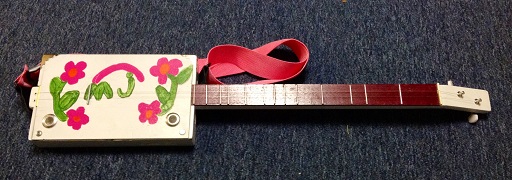


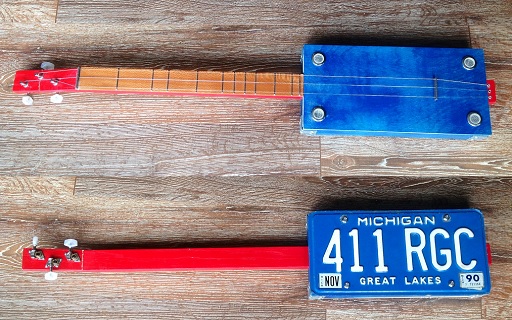
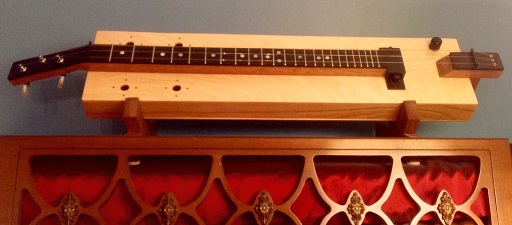
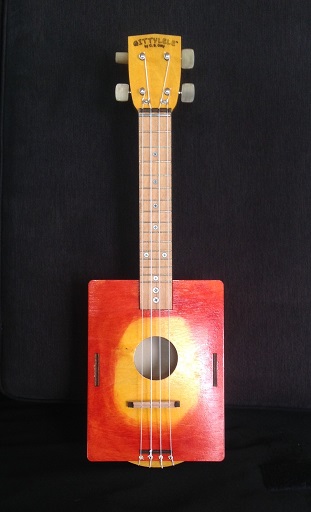
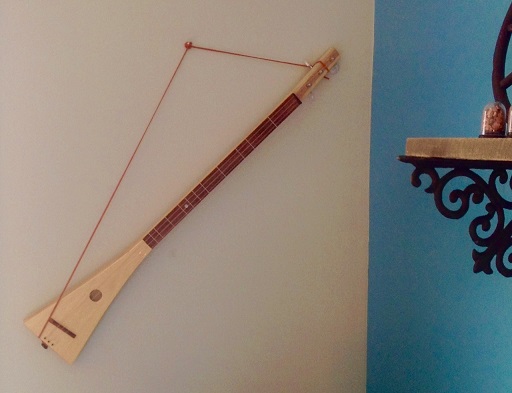
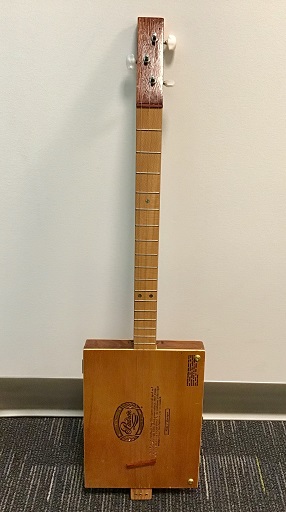

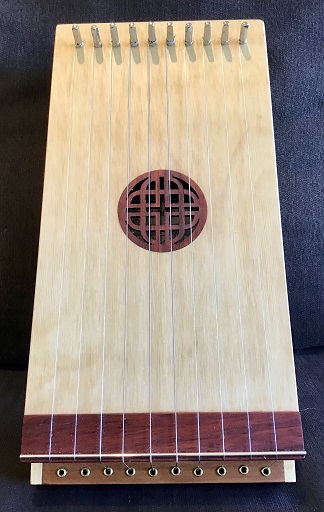 Built as a "just for fun" project with my dad. The
wood used for the string holes is cherry and the wood for the pin block
is ash. Both of those woods were from the family farm. The sound hole
and fret wire holder are padauk.
Built as a "just for fun" project with my dad. The
wood used for the string holes is cherry and the wood for the pin block
is ash. Both of those woods were from the family farm. The sound hole
and fret wire holder are padauk. 